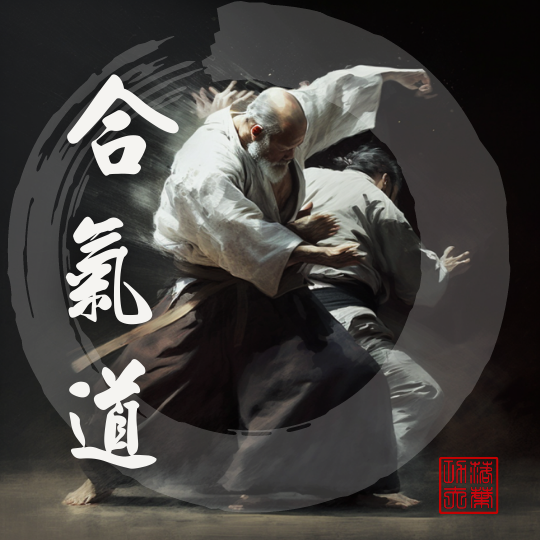
Introduction
Aikido and I Liq Chuan are two fascinating martial arts with unique philosophies and techniques. Although they share some similarities in terms of principles, their origins, development, and approaches to self-defense differ significantly.
This article will compare and contrast Aikido and I Liq Chuan, delving into their origins, philosophies, and training methodologies.
The Kanji for Aikido (合気道) consists of three characters:
- 合 (ai) meaning “harmony” or “to unite”
- 気 (ki) meaning “energy” or “spirit”
- 道 (dō) meaning “way” or “path”

Aikido: The Art of Peace
Origin: Aikido, a modern Japanese martial art, was developed in the early 20th century by Morihei Ueshiba. Ueshiba’s extensive training in Daito-Ryu Aikijutsu, a classical martial art known for its joint-locking and throwing techniques, significantly influenced the creation of Aikido. Ueshiba sought to develop a martial art that emphasized harmony and the reconciliation of conflict.
Philosophy: Aikido, often referred to as “the art of peace,” focuses on blending with an attacker’s movements to neutralize their aggression. This martial art emphasizes using minimal force, redirecting an opponent’s energy, and maintaining balance. Aikido practitioners strive to protect both themselves and their opponents, seeking a harmonious resolution to conflict.
Training: Aikido training includes practicing basic techniques, such as joint locks and throws, as well as blending exercises and weapons training. Students learn to respond to various attacks, including strikes, grabs, and weapon assaults. Aikido emphasizes fluid movements, flexibility, and body coordination.
I Liq Chuan: The Martial Art of Awareness
Origin: I Liq Chuan, or “Mental-Physical Martial Art,” is a Chinese martial art that traces its roots back to the Hakka people in the Guangdong province of China. The founder, Chin Lik Keong, developed I Liq Chuan by synthesizing elements from various martial arts, including Shaolin, Phoenix Eye, and Xingyi-Bagua. The art was later refined and systematized by his son, Grandmaster Sam FS Chin as Zhong Xin Dao.
I Liq Chuan (意力拳) is written in Chinese characters (hanzi), which are also used in Japanese as kanji. The three characters are:
- 意 (yì) meaning “mind” or “intention.”
- 力 (lì) meaning “power” or “force.”
- 拳 (quán) meaning “fist” or “boxing.”

Philosophy: The central philosophy of I Liq Chuan is the cultivation of awareness and mindfulness, both in and out of combat situations. Practitioners focus on understanding the principles of Yin and Yang, as well as the nature of force and its use. I Liq Chuan emphasizes the development of “the inner feel” and the ability to adapt to changing circumstances.
Training: I Liq Chuan training consists of solo exercises, partner drills, and sparring. Students learn various techniques to manipulate an opponent’s balance and structure, using joint locks, strikes, and throws. I Liq Chuan training emphasizes the development of sensitivity, body mechanics, and mental focus through its unique spinning and sticky hands training.
Conclusion
In conclusion, Aikido and I Liq Chuan are unique martial arts that share a common focus on harmony, balance, and adaptation. While Aikido is rooted in Japanese Daito-Ryu Aikijutsu and emphasizes blending with an opponent’s energy, I Liq Chuan is a Chinese martial art that emphasizes cultivating awareness and internal power. Both arts offer practitioners valuable tools for self-defense and personal growth, with a focus on understanding the interconnected nature of mind, body, and environment.

Read More!
- Is Pepper Spray Effective For Self Defense?
- Why Hand-to-Hand Combat Still Matters in the Firearm Era
- What is a Kung Fu Master Called?
- Woman Fight’s Off Her Attacker At The Gym!
About the Author

Ashe Higgs, I Liq Chuan Master Instructor & L2 Nutrition Coach
Ashe is a highly skilled martial arts instructor and certified nutrition coach with over two decades of experience in the field. He holds a Master Instructor certification in I Liq Chuan under Sam FS Chin, making him one of only several individuals worldwide to hold the title. He has taught classes and workshops worldwide and is passionate about helping others achieve their fitness and wellness goals.
With a background in full-contact fighting and a Level 2 certification from Precision Nutrition in nutrition coaching, Ashe is a well-rounded expert in the fields of martial arts. In addition to his expertise, he has a wealth of experience in teaching and mentoring others. He has a natural ability to connect with his students and inspire them to reach their full potential.
Disclaimers & Conflicts of Interest
I am not a doctor or a lawyer, and the information provided should not be considered medical or legal advice advice.
The information provided is for educational and informational purposes only and should not be used as a substitute for professional legal or medical advice, diagnosis, or treatment. Consult your doctor or a qualified healthcare professional before making any changes to your diet, exercise routine, or lifestyle.
Please note that some of the links provided in this content may be affiliate links, meaning that I may receive a small commission if you purchase through them. However, please rest assured that any products or services recommended are based on my personal experience and belief in their value. I only recommend products or services that I have personally used and believe in.





